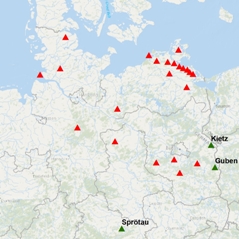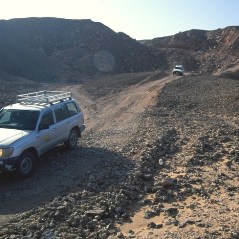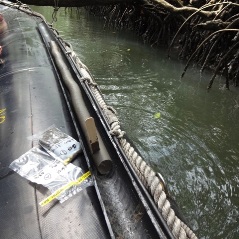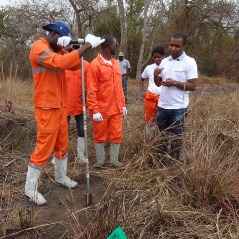Microbial Prospecting for Oil and Gas - case studies
The following case studies compare and contrast results of geo-microbial surface prospecting (MPOG®) with seismic and geological data. At the time of microbiological investigation, the authors did not have knowledge of any of the data on geological structures of the investigation areas, apart from already existing wells. The case studies were selected on basis of their exemplary character and different geological setting.
The map on the right shows the positions of surveyed areas both onshore and offshore in Central Europe.
The following colors representing MPOG® data were used for the maps discussed here.| Oil | Gas | Category |
| Background | ||
| Inconclusive zone | ||
| Anomaly B | ||
| Anomaly A |
A division of recorded microbial activities into four levels is mainly based on investigations in regions with ecological conditions like in central Europe and the North Sea. Under extreme ecological conditions (e.g. in desert regions) the average of measured activities can decline. Nevertheless, a reliable identification of positive microbial anomalies is guaranteed because of decreased background level.
The background level, which is mainly of biogenic origin, does not indicate any significant fluctuations. The additional hydrocarbon supply from oil and gas fields (e.g. from depths of ca. 2,000 m), which is confirmed by isotope analyses (delta 13C1 = -30 to -40 (‰) PDB), causes significant microbial anomalies.
By separately identifying methane and hydrocarbon oxidizing bacteria, it is possible to differentiate between oil and gas reservoirs, and oil reservoirs with a gas cap. Oil fields without a free gas cap have either no or small methane indications, but do have significant oil indications. Oil fields with a free gas cap create measurable methane anomalies and increased oil indications. Gas fields in the North Sea, which contain beside methane also aliphatic hydrocarbons (ca. 15%) show oil indications as well as significant methane indications. The intensity of these oil indications however is normally below the indication level for oil fields.




